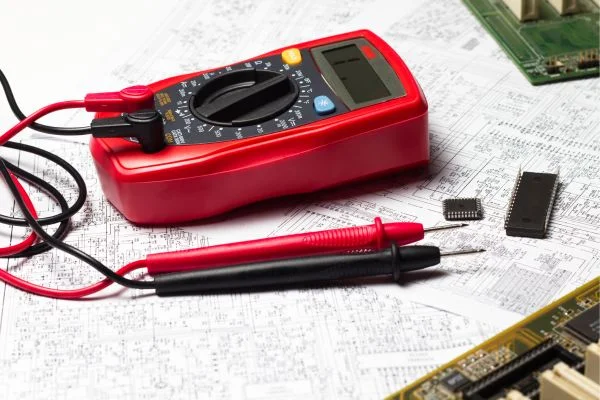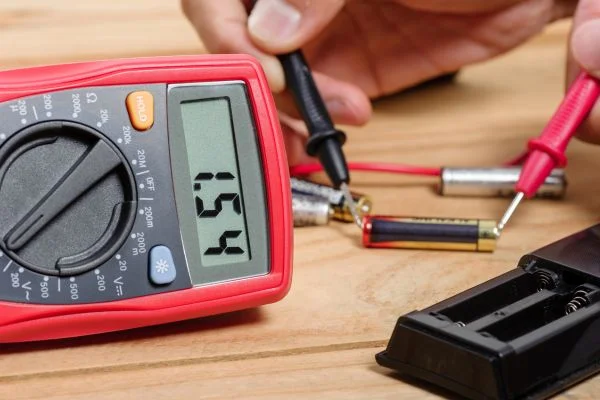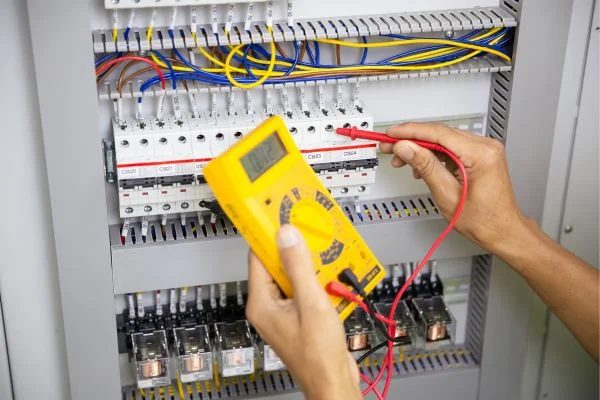In the world of multimeters, a new breakthrough has the Non-Contact Voltage (NCV) feature. By detecting live wires without physical contact, NCV technology is revolutionizing the way we approach electrical work. If you know what is multimeter, then you have a better understanding of what is ncv on a multimeter. Not only are you familiar with NCV, you also understand what multimeter symbols mean.
What Is A Multimeter?
The multimeter is a versatile electronic device that measures a variety of electrical properties in circuits and components. The unit usually combines several functions into one compact unit, making it an essential tool for electricians, electronics enthusiasts, and technicians.
A multimeter measures voltage, current, and resistance, which are fundamental parameters in electrical systems. Their displays allow users to read measurements accurately, whether they are digital or analog.

What Is NCV On A Multimeter?
Many modern digital multimeters come with NCV (Non-Contact Voltage), a useful feature. Electricians and technicians can quickly detect the presence of alternating current (AC) voltage in a circuit or electrical device without making direct physical contact.

Users can use this feature to detect live electrical wires or components without having to expose themselves to potential electrical hazards. Typically, NCVs are used when traditional probe-based voltage measurement methods are impractical or unsafe.
As a result, it is easy to identify live wires behind walls, in electrical outlets, or within cable bundles without having to make any physical contact. For professionals and DIY enthusiasts who need to quickly determine whether circuits or electrical equipment are energized, NCV is an invaluable tool that promotes safety and efficiency.
What Is The Use Of The NCV Function Of The Multimeter?
A multimeter’s ncv function (Non-Contact Voltage) allows electricians and technicians to detect alternating current (AC) voltages in a non-contact, safe way. If you need to identify live wires or determine if a circuit is energized without making direct contact, this function is particularly useful.

Safety and Non-Contact Detection:
This function is primarily designed to enhance safety. Holding the multimeter close to a wire or electrical component allows it to detect AC voltage without physically touching it. Avoiding accidents and injuries when working on live circuits is crucial.
Quick Voltage Identification:

NCV is an efficient and quick way to identify live wires, outlets, and circuits. This is especially helpful when dealing with complicated wiring systems or when you’re uncertain about voltage levels.
Sensitivity Adjustment:
In many multimeters with an NCV function, the sensitivity can be adjusted. As a result of this feature, it can detect different levels of voltage, making it versatile for a variety of applications. The sensitivity can be adjusted depending on the voltage range you are interested in detecting.
Visual and Audible Alerts:

There are often visual and audible indicators on multimeters with NCV functions. It is easier to confirm AC voltage presence when the multimeter lights up or emits a sound when it detects voltage.
Non-Invasive Troubleshooting:
During troubleshooting, electricians use ncv functions. Electrical faults can be pinpointed, and areas of concern can be identified without interrupting the circuit.
NCV Types And Technologies
Different types and technologies are used to make non-contact voltage detection work effectively. Various types and technologies of NCV have evolved to meet different needs.
Contact NCV
Contact NCV, as its name implies, involves direct physical contact with conductive material. Detecting voltage using this method requires probes or wires to touch the object. In spite of its accuracy, it is less commonly used than non-contact methods due to the potential for electrical shock.
Non-contact NCV

The most common method for measuring non-contact voltage is non-contact NCV, which is often incorporated into modern multimeters. Circuits are not physically touched by it. Voltage instead generates electromagnetic fields that are detected by the device. Among professionals and DIY enthusiasts, this technology is safer and more convenient for everyday use.
Hybrid NCV
A hybrid NCV combines the advantages of both contact and non-contact methods. Based on the situation, users can choose between direct contact with the object and non-contact detection. When dealing with sensitive electronic components or when measuring voltage in a traditional manner, this versatility is useful.
Advanced NCV Technologies
Voltage detection accuracy and sensitivity have been enhanced with advanced NCV technologies. A few of these features include adjustable sensitivity settings, visual and audible alarms, and the ability to distinguish between different voltage levels. As a result of these advancements, voltage detection is more precise and efficient, meeting specific professional requirements.
How To Use NCV On A Multimeter?
There are times when people wonder what is ncv on a multimeter before using this feature. Using NCV mode on a multimeter is as simple as following these steps.

Step 1: Power On the Multimeter
Ensure that your multimeter is powered on and functioning correctly before using the NCV feature. The multimeter’s display should be functional, and the battery should be in good condition. NCV cannot function without power.
Step 2: Select NCV Mode
An icon resembling a Wi-Fi symbol or a lightning bolt usually indicates a multimeter’s NCV mode. You can select this mode by turning the dial or navigating the menu. The multimeter is now set to detect NCVs.
Step 3: Approach the Target
You should hold the multimeter with the NCV sensor end facing the area or object you want to measure the voltage on. Typically, you should keep a safe distance between you and the target, between several inches and a foot. Be sure to keep your hands steady.
Step 4: Observe the Display
Monitor the multimeter’s display as you move the NCV sensor closer to the target. Voltage will be indicated visually or audibly by the NCV function. Different multimeters provide different indications.
Step 5: Interpret the Results
The multimeter will provide a clear indication when it detects voltage using the NCV feature. Either a light or a sound could be the signal. Understanding how a multimeter conveys this information is crucial. The indication indicates that there is live voltage nearby.
Step 6: Safety Precautions
It is easy and safe to detect voltage with the NCV feature, but it is important not to become complacent. Any electrical source should be treated as potentially hazardous. When dealing with electrical systems, proceed with caution and ensure safety measures are followed.
Common Misconceptions About NCV
Non-contact voltage detection (NCV) is a valuable tool, but there are several misconceptions that can cause confusion. In order to ensure that users have a clear understanding of NCV technology, let’s address and debunk these misconceptions.
1-Limited Detection Range

There is a misconception that NCV has a limited detection range. It is actually possible to detect voltages ranging from low to high with NCV multimeters. Depending on your voltage detection needs, the sensitivity may vary between models, so it’s important to choose the right multimeter. NCV multimeters cover a broad spectrum, making them suitable for a variety of applications.
2-False Positives and Negatives
There are some users who are concerned about false positives or negatives when using NCV. Modern NCV technology is designed to minimize false alarms caused by electromagnetic interference or nearby electrical sources. It is possible to reduce false positives by following proper measurement procedures, and advanced NCV multimeters can filter out interference, providing more accurate measurements.
3-NCV as a Replacement for a Professional Electrician
A common misconception is that NCV multimeters can replace the expertise of professional electricians. NCV tools are valuable for preliminary checks and troubleshooting, but they cannot substitute for professional knowledge and experience. For complex electrical issues and installations, you should consult a certified electrician.
Conclusion
When you are familiar with multimeter symbols, such as what is NCV on a multimeter,, you will be able to use them safely and effectively. The electronic things can be easily checked with a multimeter if you are familiar with it.
